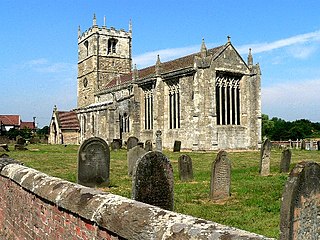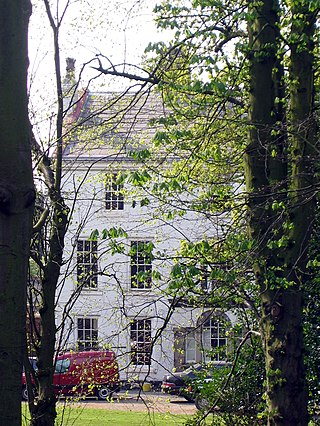
Skipwith is a village and civil parish about 4 miles (6.4 km) north-east of Selby and 10 miles (16 km) south-east of York in North Yorkshire, England. It was historically in the East Riding of Yorkshire. After the 1974 local government reorganisation Skipwith was in the Selby District of the shire county of North Yorkshire. In 2023 the district was abolished and North Yorkshire became a unitary authority.

83 Welsh Row is a Georgian town house in Nantwich, Cheshire, England, dating from the late 18th century, located on the south side of Welsh Row. It is currently used as offices. It is listed at grade II*; in the listing, English Heritage describes it as "a good tall late C18 house", featuring a "good doorway".

140–142 Hospital Street, sometimes known as Hospital House, is a substantial townhouse in Nantwich, Cheshire, England, located on the south side of Hospital Street. The building is listed at grade II. It was built in the late 16th century by John Crewe, a tanner, whose sons Randolph and Thomas both served as the Speaker of the House of Commons. The original timber-framed, close-studded façade has been concealed by alterations during the late 17th century; these include the addition of small-paned casement windows, some of which contain old heraldic stained glass. The building was further altered and extended in the 18th century, with the addition of two Gothic-style entrances. Later occupants include the architect, Thomas Bower, and the building remains in residential use.

The Gateway, or 60–62 Welsh Row, is a Late Georgian former stable entrance in Nantwich, Cheshire, England, dating from the early 19th century. It is located on the north side of Welsh Row, on the junction with Red Lion Lane. It is listed at grade II. Nikolaus Pevsner describes The Gateway as "handsome".

Combermere House, or 148 Hospital Street, is a Georgian town house in Nantwich, Cheshire, England, which dates from the mid-18th century. It is on the south side of Hospital Street, near the end of the street and opposite the junction with Millstone Lane. The building has previously been known by other street numbers, including number 154. It is listed at grade II, and local historian Jane Stevenson describes it as "sheer perfection".

Mount Pleasant is an 18th-century mansion situated on Sharrow Lane in the Highfield area of the City of Sheffield in South Yorkshire, England. The house stands just under two km south of the city centre and is a grade II* listed building, it has been described as "one of the best 18th century houses in Sheffield". The adjacent former stables and coach house are also Grade II* listed.

Asia House at No. 82 Princess Street, Manchester, England, is an early 20th century packing and shipping warehouse built between 1906 and 1909 in an Edwardian Baroque style. It is a Grade II* listed building as at 3 October 1974. Nikolaus Pevsner's The Buildings of England describes the warehouse, and its companion, No. 86, Manchester House, as "quite splendid ... good examples of the warehouse type designed for multiple occupation by shipping merchants". It attributes its design to I.R.E. Birkett, architect of the Grade II listed companion building, Manchester House, which is similar in design. English Heritage attributes it to Harry S. Fairhurst. Asia House has an "exceptionally rich" entrance hall and stairwell, "lined with veined marble and green and cream faience, with designs of trees and Art Nouveau stained glass".

Hankelow Hall is a former country house to the north of the village of Hankelow, Cheshire, England.

Lawton Hall is a former country house to the east of the village of Church Lawton, Cheshire, England. The building has since been used as a hotel, then a school, and has since been converted into separate residential units. It is recorded in the National Heritage List for England as a designated Grade II listed building.

Lower Kinnerton Hall, also known as Bridge Farmhouse, stands adjacent to the England-Wales border to the west of the village of Lower Kinnerton, Cheshire, England. The house is dated 1685, and carries the initials TTET. Attached to it is a shippon (cattle-shed) dating from the 18th century. A wing was added to the rear in the 19th century. The house is constructed in brown brick with stone dressings, and has a slated roof. It is in two storeys and its entrance front has five bays. There are three large Dutch gables on the entrance front, and another on the north face, each with reverse-curved scrolls supporting pediments. The windows are casements. At the rear of the house is a semi-hexagonal bay window and a timber-framed porch. The shippon is also in two storeys, and constructed in brick with slate roofs. Also at the rear of the house is a cobbled courtyard. The architectural historian Nikolaus Pevsner describes the building as "quite an impressive house". The house and attached shippon are recorded in the National Heritage List for England as a designated Grade II listed building.

Over Tabley Hall is a country house in the parish of Tabley Superior in Cheshire, England. It stands in an isolated position to the northwest of junction 19 of the M6 motorway.

Hurdsfield House is a former country house, now surrounded by housing, in the town of Macclesfield, Cheshire, England. It was built for a branch of the Brocklehurst family. During the 20th century it was used as a welfare clinic. The house dates from about 1800, with later additions and alterations. It is constructed in brick with stone dressings, and has Welsh slate roofs. The house is in three storeys, and its entrance front, facing west, has five bays. In the central bay is a porch with a Doric architrave, over which is a balcony with wrought iron railings. Behind and above this is a tall window with an entablature. The windows are sashes, and at the corners of the house are quoins. The south front originally had three bays, and a further bay has been added to the right. In the angle at the rear of the house is an extension added later in the 19th century. The house is recorded in the National Heritage List for England as a designated Grade II listed building. It has been divided into flats.

Hapsford Hall is a country house about 1 mile (1.6 km) south-west of Helsby, Cheshire, England. It was built in the late 18th or early 19th century and incorporates a former farmhouse; additions and alterations have been made since it was built. It is constructed in brick and stone, stands on a stone plinth, and has stone quoins and a hipped slate roof. The house is in three storeys, with cellars and an attic, and has a symmetrical front of three bays. Most of the windows on the front are sashes; elsewhere are casement windows. An embattled stone porch projects from the centre. The house is recorded in the National Heritage List for England as a designated Grade II listed building.

Moore Hall is a country house located in the village of Moore, Cheshire, England. It was built in the early 18th century, and is constructed in roughcast brick with a slate roof. The house has three storeys, and is in five bays. The porch is a more modern, and is fronted by a Venetian window. The windows are sashes. The house is recorded in the National Heritage List for England as a designated Grade II* listed building.

Chester Royal Infirmary is a former hospital on City Walls Road, Chester, Cheshire, England. The original hospital building, which was founded in the mid 18th century, is recorded in the National Heritage List for England as a designated Grade II listed building. The hospital was expanded in the early 20th century. It closed in the 1990s. The site has been redeveloped for apartments and housing.
Hampton Hall is a country house in Worthen, Shropshire.

St George's Church is a former church in High Street, Macclesfield, Cheshire, England. It is recorded in the National Heritage List for England as a designated Grade II listed building.

Ince Blundell Hall is a former country house near the village of Ince Blundell, in the Metropolitan Borough of Sefton, Merseyside, England. It was built between 1720 and 1750 for Robert Blundell, the lord of the manor, and was designed by Henry Sephton, a local mason-architect. Robert's son, Henry, was a collector of paintings and antiquities, and he built impressive structures in the grounds of the hall in which to house them. In the 19th century the estate passed to the Weld family. Thomas Weld Blundell modernised and expanded the house, and built an adjoining chapel. In the 1960s the house and estate were sold again, and have since been run as a nursing home by the Canonesses of St. Augustine of the Mercy of Jesus.

23 High Petergate is a grade I listed building in the city centre of York, in England.

St Oswald's Hall is a grade II* listed former church in Fulford, in south-eastern York, in England.



















